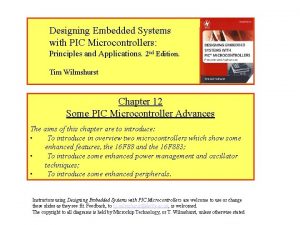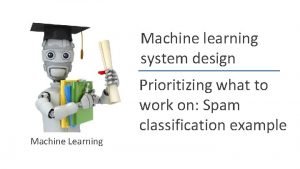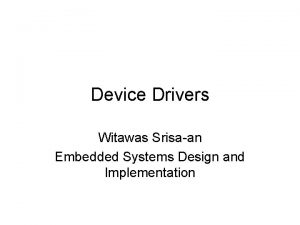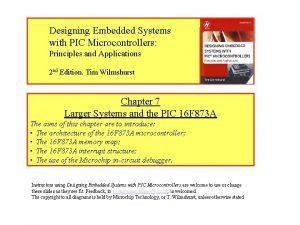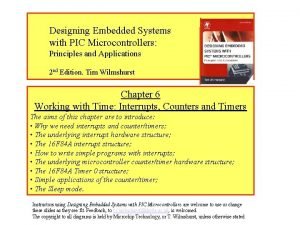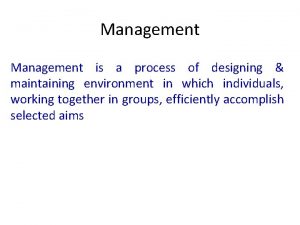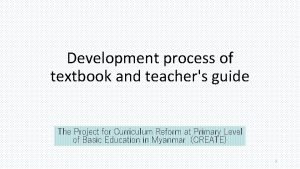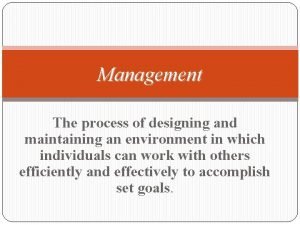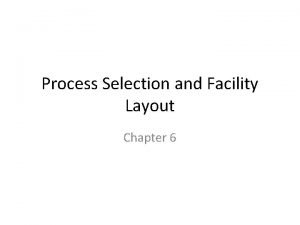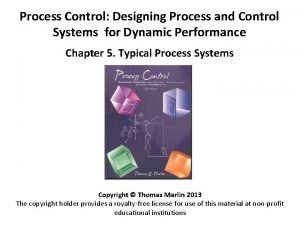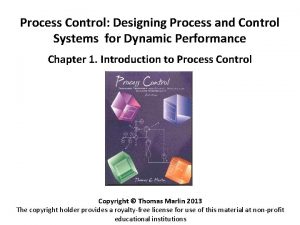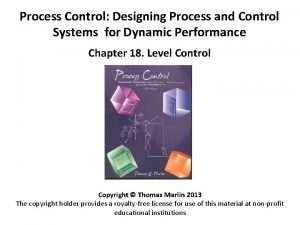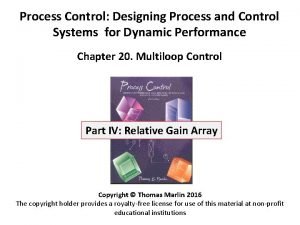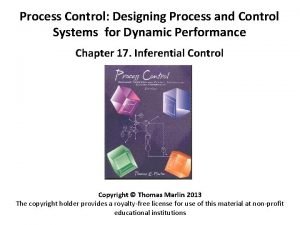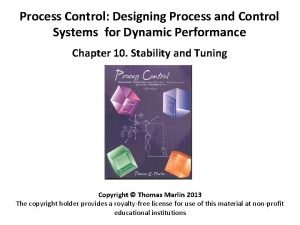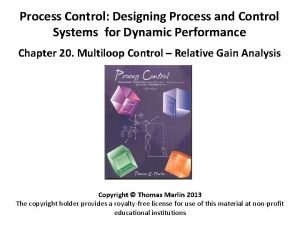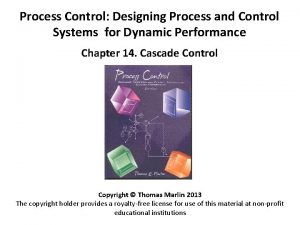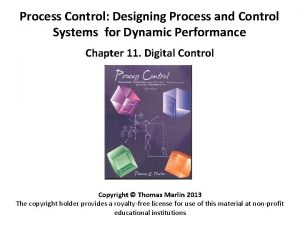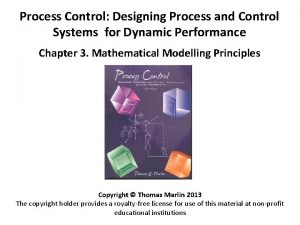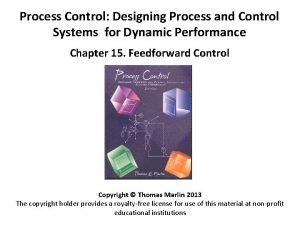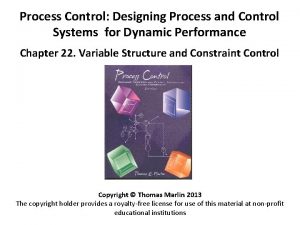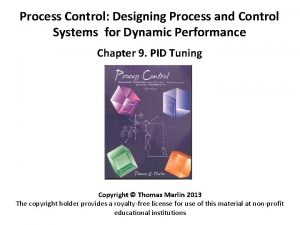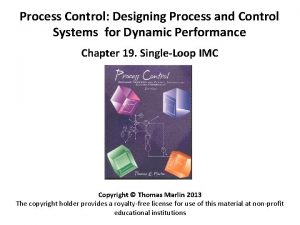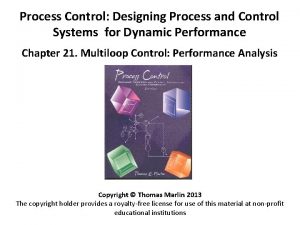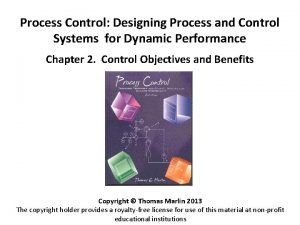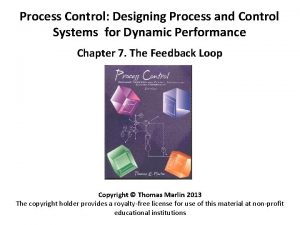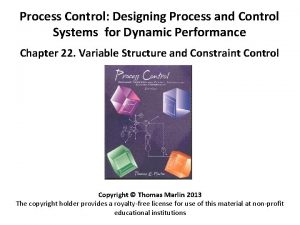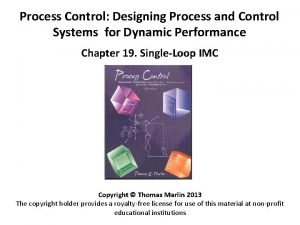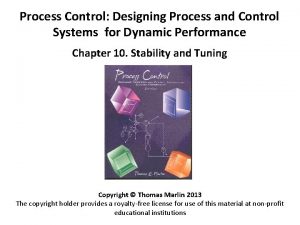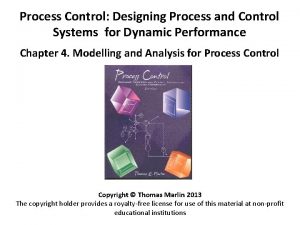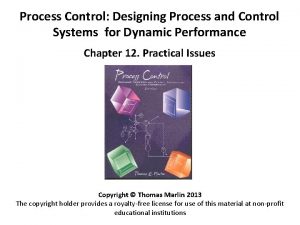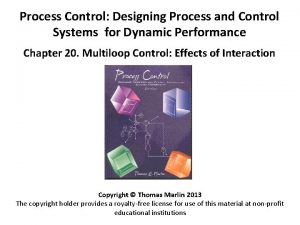Process Control Designing Process and Control Systems for













































- Slides: 45

Process Control: Designing Process and Control Systems for Dynamic Performance Chapter 23. Centralized Model Predictive Control Copyright © Thomas Marlin 2013 The copyright holder provides a royalty-free license for use of this material at non-profit educational institutions

CHAPTER 23: Centralized MPC Control When I complete this chapter, I want to be able to do the following. • Explain centralized control • Build a discrete process model • Explain the trajectory optimization for MPC • Explain the advantages of MPC • Describe criteria for selecting MPC over multiloop control

CHAPTER 23: Centralized MPC Control Outline of the lesson. • Review IMC structure and principles • Develop MPC for SISO • Generalize MPC for MIMO • Discuss important enhancements • Explain key insights • Develop application guidelines

CHAPTER 23: Centralized MPC Control Centralized Control uses all CV measurements to calculate all manipulated variables simultaneously. Describe decentralized control and compare with centralized. Centralized F Controller T L A

CHAPTER 23: Centralized MPC Control Centralized F Centralized Control is applied to control systems with interaction. Controller T L A • All process information is used by the controller • Better control performance is possible • Substantial increases in controller complexity and real-time computations

CHAPTER 23: Centralized MPC Control Centralized Control developed in the 1960’s with major enhancements around 1980. Centralized F Controller T L A • Original use was limited to few industries and highly skilled practitioners • Now widely applied in many industries • Good software facilitates applications • We will discuss the Dynamic Matrix Control approach, using the IMC control structure

CHAPTER 23: Centralized MPC Control D(s) SP(s) + - Tp(s) GMPC(s) MV(s) Gv(s) Centralized controller Gd(s) GP(s) Gm(s) CV(s) + + - + Em(s) Let’s recall the IMC structure Transfer functions Variables GMPC(s) = controller Gv(s) = valve GP(s) = feedback process Gm(s) = model Gd(s) = disturbance process CV(s) = controlled variable CVm(s) = measured value of CV(s) D(s) = disturbance Em(s) = model error MV(s) = manipulated variable SP(s) = set point Tp(s) = set point corrected for model error

CHAPTER 23: Centralized MPC Control D(s) SP(s) + - Tp(s) GMPC(s) MV(s) Centralized controller Gv(s) Gd(s) GP(s) Gm(s) CV(s) + + - + Em(s) The variables are vectors The transfer functions are matrices

CHAPTER 23: Centralized MPC Control From Chapter 19, we know that the IMC structure must obey the following criteria. 1. The controller steady-state gain must be the inverse of the model gain. 2. Perfect control requires an exact inverse. 3. Realistic control cannot “look into the future” or invert models that lead to unstable controllers.

CHAPTER 23: Centralized MPC Control What does the MPC Controller calculate? • It determines the best (optimal) trajectory from the current conditions to the set point. • To perform this calculation using the DMC approach, we need a model that gives predictions of discrete values, rather than a continuous transfer function. • Therefore, we start with a modified modelling approach.

CHAPTER 23: Centralized MPC Control Modelling approach: Although we could use fundamental models, the basis for nearly all applications are empirical models. input variable output variable Empirical identification Continuous Model using process reaction curve or statistics 0 time Could we use the data from the experiment as the model? Sampled output model for unit step with t = 2. 5 minutes Sample number 0 1 2 3 4 5 6 7 8 9 10 11 0 0. 394 0. 632 0. 777 0. 864 0. 918 0. 950 0. 970 0. 982 0. 989 Step here

CHAPTER 23: Centralized MPC Control Modelling approach: 1. Inputs can be represented as a series of steps. 2. The effect of a step of magnitude MV is the magnitude times the unit step model. Controlled Variable 3. The output effect of a sequence of inputs is the sum of each input effect. S-LOOP plots deviation variables (IAE = 20. 0383) 1. 5 1 0. 5 Manipulated Variable 0 0 50 100 Time 150 200 250 50 40 30 20 10 0 0 Time

CHAPTER 23: Centralized MPC Control Modelling approach: Directly performed using matrices. Step model, ak 0 1 2 3 4 5 6 7 8 9 10 11 0 0. 394 0. 632 0. 777 0. 864 0. 918 0. 950 0. 970 0. 982 0. 989 Dynamic Matrix A MV = CV Notes: 1. The MV& CV subscripts represent samples (different times) 2. The CV values are deviation from initial steady state 3. Some time after the input step, the process achieves steady state and the model values (ak) are constant at Kp

CHAPTER 23: Centralized MPC Control Basic controller calculation: Open-loop trajectory SP(s) + - Tp(s) GMPC(s) MV(s) CV(s) Gv(s) GP(s) The controller calculates the manipulations in the future that will achieve the control objective - which for now is closely tracking the set point.

CHAPTER 23: Centralized MPC Control Error at each time step that is reduced by the future values of the manipulated variable adjustments determined by the controller Set point . . Controlled variable calculated using model and past values of manipulated variable Past values of the manipulated variable Calculated by MPC Controller Future values of the manipulated variable determined by the controller future past Time Only the current result is implemented

CHAPTER 23: Centralized MPC Controller calculation: Controller minimizes sum of squares of error. First, calculate the response if no future moves occurred, CVf. This includes the affects of past moves. Second, calculate the error if no future moves occurred, Ef. Third, calculate the manipulation to minimize the goal given below. with CVc the effect of the controller manipulation at the current and future times

CHAPTER 23: Centralized MPC Controller calculation: Controller minimizes sum of squares of error. Means minimize by adjusting values of MVc Quadratic objective with linear equations; can be solved Model relates MVc to CVc Solution is least squares equations, involving solution to linear equations offline and simple matrix-vector product online.

CHAPTER 23: Centralized MPC Controller calculation: Example for single I/O controller with perfect model. Why didn’t the CV track the set point exactly? concentration 3 2. 5 2 1. 5 1 0. 5 0 40 60 80 100 55 valve opening We calculated four steps, but only two changed; why? 20 50 45 0 50 Time 100 150

CHAPTER 23: Centralized MPC Controller calculation: We have to added feedback! SP(s) + - Tp(s) GMPC(s) MV(s) Why feedback? CV(s) Gv(s) GP(s) Gm(s) Em(s) Feedback + - +

CHAPTER 23: Centralized MPC Control Error (corrected by feedback) at each time step that is reduced by the future values of the manipulated variable adjustments determined by the controller Current measured value of the controlled variable What do we assume about the model error? . . Set point Model mismatch, Emm Controlled variable calculated using model and past values of manipulated variable, without feedback Controlled variable calculated using model and past values of manipulated variable Past values of the manipulated variable Future values of the manipulated variable determined by the controller future past Time

CHAPTER 23: Centralized MPC Controller calculation: Example for single I/O controller with feedback; model error of 35% in gain only. Returned to set point; why? concentration 3 2. 5 2 1. 5 1 0. 5 0 20 40 60 80 100 Diagnose this performance? valve opening 55 50 45 0 50 Time 100 150

CHAPTER 23: Centralized MPC Controller calculation: We have be able to tune the controller! We want robustness and moderate MV adjustments. Not acceptable SP(s) + - Tp(s) GMPC(s) MV(s) CV(s) Gv(s) GP(s) Gm(s) Em(s) + - +

CHAPTER 23: Centralized MPC Controller calculation: Controller minimizes sum of squares of error with penalty on MV moves ( MV 2). Quadratic objective with linear equations; can be solved Solution is least squares equations, involving solution to linear equations offline and simple matrix-vector product online.

CHAPTER 23: Centralized MPC Control 25. 00 9. 00 20. 00 controlled variable ISE 10. 00 8. 00 15. 00 7. 00 10. 00 6. 00 5. 00 0. 10 0. 20 0. 30 0. 40 0. 50 0. 60 move suppression, qq 0. 70 0. 80 0. 90 1. 00 manipulated variable ISE Tuning: Increasing the move penalty (qq/ww) reduces the manipulation magnitude rapidly with small increase in CV variation. Example results for SISO system in example. (ww = 1)

CHAPTER 23: Centralized MPC Controller calculation: Example for single I/O controller with feedback; model error of 35% in gain only and with ww = 1. 0 and qq = 0. 20. Diagnose and recommend fine tuning. concentration 3 2. 5 2 1. 5 1 0. 5 0 20 40 60 80 100 Diagnose and recommend fine tuning. valve opening 55 50 45 0 50 Time 100 150

CHAPTER 23: Centralized MPC Control A great advantage of MPC is the direct application to centralized multivariable control using the same principles. How does this differ from PID composition control?

CHAPTER 23: Centralized MPC Control Modelling approach: Must include effects from every MV to every CV. Dynamic Matrix A MV = CV Notes: 1. Aij is the dynamic matrix between output i and input j 2. [ MVj] and [CVi] are vectors of the values for each variable over the horizon

CHAPTER 23: Centralized MPC Controller calculation: Controller minimizes sum of squares of all errors with penalty on all MV moves. Quadratic objective with linear equations; can be solved Solution is least squares equations, involving solution to linear equations offline and simple matrix-vector product online.

CHAPTER 23: Centralized MPC Controller calculation: Sample distillation without model error and with move suppression. Why did this change? 0. 99 Why slow for fast process? 0. 985 100 200 300 0. 022 0. 021 0. 02 0. 018 0 Reboiled vapor, FV Reflux, FR 9. 4 9. 2 9 8. 8 8. 6 8. 4 0 0. 023 0. 019 0. 98 0 Bottoms, XB Distillate, XD 0. 024 100 200 Time 300 400 100 200 300 How much delay before this changed? 14. 4 14. 2 14 13. 8 13. 6 13. 4 0 100 200 Time 300 400

CHAPTER 23: Centralized MPC Controller calculation: The following parameters are adjusted by the engineer. t The controller execution period NN The controlled variable horizon, which should be the time to reach steady state MM The manipulated variable horizon ( NN/4) ww The weight on each controlled variable; can be used to represent different relative importances qq The individual manipulated variable move suppressions; these have units!

CHAPTER 23: Centralized MPC Controller calculation: An important enhancement includes possible limits on CVs and MVs. Penalty for any violation of controlled variables bounds, D 0 Hard bounds on the manipulated variables

CHAPTER 23: Centralized MPC Controller calculation: Sample distillation without model error, move suppression, and bound on manipulated variable. Bottoms, XB 0. 024 0. 985 0. 98 0. 975 0 50 100 150 Time 200 250 0. 022 0. 018 0 9. 5 50 100 150 Time 200 250 14. 5 Reboiled vapor Upper bound on reboiler vapor Reflux Discuss the control performance. Distillate, XD 0. 99 9 8. 5 0 50 100 150 Time 200 250 14 13. 5 0 50 100 150 Time 200 250

CHAPTER 23: Centralized MPC Controller calculation: Sample distillation without model error, move suppression, and bound on controlled variable. Bottoms, XB 0. 024 0. 985 0. 98 0. 975 0 50 100 150 Time 200 250 0. 02 0. 018 0 50 100 150 Time 200 250 Reboiled vapor 14. 5 9 8. 5 Upper bound on XB 0. 022 9. 5 Reflux Discuss the control performance. Distillate, XD 0. 99 0 50 100 150 Time 200 250 14 13. 5

CHAPTER 23: Centralized MPC Control KEY INSIGHTS • The MPC design methods yields easily solved optimization problems, least squares (unconstrained, offline) or quadratic programming, QP (constrained, online) • The constrained controller does not have a fixed control calculation; it changes in response to the active constraints • The calculation of the QP is much more complex than typical controllers, but it gives extraordinary features. - The QP is convex, so that the global optimum is guaranteed at the solution. - Essentially every MPC includes the QP

CHAPTER 23: Centralized MPC Control KEY INSIGHTS • The MPC controller can easily be formulated for “nonsquare” systems, i. e. a different number of manipulated and controlled variable. • The MPC controller can calculate the feedforward compensation for measured disturbances using the same, unmodified optimization. Only Ef is changed. • The MPC can be used to display the predicted future transient to the operators. • MPC controllers can handle large systems, certainty 10+ CVs and MVs, with much larger industrial applications reported

CHAPTER 23: Centralized MPC Control MPC APPLICATION GUIDELINES • Use MPC for MIMO systems; SISO can use PID or IMC • Non-square systems of high complexity, where signal select and split range become too complex • Process systems with complex dynamics • Process systems that often encounter constraints and the constraint activity changes • MPC usually is arranged in a cascade structure resetting the set points of regulatory PID (or IMC) controllers • See next slide for a small example of MPC

CHAPTER 23: Centralized MPC Control OPERATING OBJECTIVES • Total “conversion” is key quality, measured by weighted average bed temperature • Exothermic reactor beds must not “run away” • Reaction in each bed depends on strategy, max selectivity or max catalyst life • T 10 should be low, but the bypass valve v 01 (adjusted by T 01) should be opened for fast control

CHAPTER 23: Centralized MPC Control COMMERCIAL MPC PRODUCTS • Involve complex software, transparent to user • Integrated empirical modelling and controller design • Simulation test bed for controller tuning and evaluation • Design and tuning on PC/Workstation with download of controller parameters to DCS • Many other features not discussed here, e. g. , - Steady-state optimization - Check for controllability and conditioning - Features for unstable processes (levels and other) - Enhanced feedback with disturbance model

CHAPTER 23: MPC CONTROL WORKSHOP 1 The MPC control objective involved the square of error (and move sizes). Discuss the advantages and disadvantages of using the power 2 (and not 1, 3, 4, 1/2, absolute value, etc. ) Hint: The choice is not arbitrary; it provides important advantages.

CHAPTER 23: MPC CONTROL WORKSHOP 2 Describe the sequence of calculations performed in the offline design of MPC. Restrict your presentation to the unconstrained, multivariable MPC. • Begin with the empirical identification • Include parameters that are manually inputted • Organize the calculations in the order performed Solution is least squares equations, involving solution to linear equations offline and simple matrix-vector product online.

CHAPTER 23: MPC CONTROL WORKSHOP 3 Describe the sequence of calculations performed by the MPC online controller at every execution. • Identify information from controller design, manual entry, and sensors • Organize the calculations in the order performed SP(s) + - Tp(s) GMPC(s) MV(s) CV(s) Gv(s) GP(s) Gm(s) Em(s) + - +

CHAPTER 23: MPC CONTROL WORKSHOP 4 Would you recommend applying multivariable MPC for control of the flash process? T 6 Feed Methane Ethane (LK) Propane Butane Pentane T 1 P 1000 k. Pa T 298 K T 4 F 2 P 1 T 5 T 2 F 1 Vapor product T 3 L 1 F 3 A 1 Process fluid Steam L. Key Liquid product

CHAPTER 23: Centralized MPC Control When I complete this chapter, I want to be able to do the following. • Explain centralized control • Build a discrete process model • Explain the trajectory optimization for MPC • Explain the advantages of MPC • Describe criteria for selecting MPC over multiloop control Lot’s of improvement, but we need some more study! • Read the textbook • Review the notes, especially learning goals and workshop • Try out the self-study suggestions • Naturally, we’ll have an assignment!

CHAPTER 23: LEARNING RESOURCES • SITE PC-EDUCATION WEB - Tutorials (Chapter 23) • The Textbook, naturally, for more examples. • Addition information on MPC control is given in the following references. Brosilow, C. and B. Joseph, Techniques of Model-Based Control, Prentice Hall, Upper Saddle River, 2002 - Some additional introductory material on MPC Maciejowski, J. M. , Predictive Control with Constraints, Prentice Hall, Harlow, England, 2002 - A clearly presented, comprehensive presentation at the advanced level Qin, S. J. and T. Badgwell - A Survey of industrial model predictive control technology, Control Engineering Practice, 11, 733 -764, 2003

CHAPTER 23: SUGGESTIONS FOR SELF-STUDY 1. Discuss the similarities and differences between IMC and MPC algorithms. 2. Find a recent journal article with an industrial application of MPC. Describe why you think that MPC was a good (or poor) choice for control. 3. Prove that the solution to the MPC controller gain (KMPC) is the least squares equation. 4. Discuss the effect of one or more manipulated variable encountering and remaining at a bound (either upper or lower). 5. Compare PID with decoupling with multivariable MPC; discuss advantages of each.
 Designing embedded systems with pic microcontrollers
Designing embedded systems with pic microcontrollers Machine learning system design examples
Machine learning system design examples Designing device drivers for embedded systems
Designing device drivers for embedded systems Data memory
Data memory Designing embedded systems with pic microcontrollers
Designing embedded systems with pic microcontrollers The process of designing and maintaining an environment
The process of designing and maintaining an environment Textbook development process
Textbook development process The process of designing and maintaining an environment
The process of designing and maintaining an environment Layout
Layout Closeness rating examples
Closeness rating examples Process control systems
Process control systems Product and process control
Product and process control Fspos
Fspos Novell typiska drag
Novell typiska drag Nationell inriktning för artificiell intelligens
Nationell inriktning för artificiell intelligens Returpilarna
Returpilarna Shingelfrisyren
Shingelfrisyren En lathund för arbete med kontinuitetshantering
En lathund för arbete med kontinuitetshantering Adressändring ideell förening
Adressändring ideell förening Tidböcker
Tidböcker Anatomi organ reproduksi
Anatomi organ reproduksi Vad är densitet
Vad är densitet Datorkunskap för nybörjare
Datorkunskap för nybörjare Tack för att ni lyssnade bild
Tack för att ni lyssnade bild Mall debattartikel
Mall debattartikel För och nackdelar med firo
För och nackdelar med firo Nyckelkompetenser för livslångt lärande
Nyckelkompetenser för livslångt lärande Påbyggnader för flakfordon
Påbyggnader för flakfordon Lufttryck formel
Lufttryck formel Offentlig förvaltning
Offentlig förvaltning Jag har gått inunder stjärnor text
Jag har gått inunder stjärnor text Presentera för publik crossboss
Presentera för publik crossboss Teckenspråk minoritetsspråk argument
Teckenspråk minoritetsspråk argument Plats för toran ark
Plats för toran ark Klassificeringsstruktur för kommunala verksamheter
Klassificeringsstruktur för kommunala verksamheter Luftstrupen för medicinare
Luftstrupen för medicinare Bästa kameran för astrofoto
Bästa kameran för astrofoto Centrum för kunskap och säkerhet
Centrum för kunskap och säkerhet Byggprocessen steg för steg
Byggprocessen steg för steg Mat för unga idrottare
Mat för unga idrottare Verktyg för automatisering av utbetalningar
Verktyg för automatisering av utbetalningar Rutin för avvikelsehantering
Rutin för avvikelsehantering Smärtskolan kunskap för livet
Smärtskolan kunskap för livet Ministerstyre för och nackdelar
Ministerstyre för och nackdelar Tack för att ni har lyssnat
Tack för att ni har lyssnat Referatmarkeringar
Referatmarkeringar
